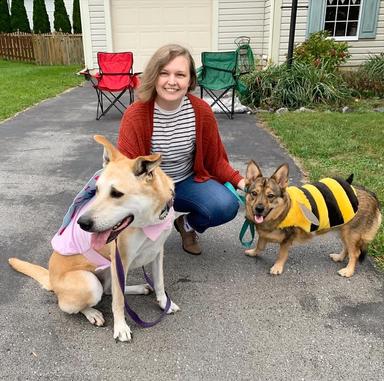How to Adopt a Therapy Dog
Interested in adopting a therapy dog? Read more to learn about the adoption process and what to expect.
Interested in adopting a therapy dog? Read more to learn about the adoption process and what to expect.
by Savannah Admire, | September 12, 2023

Jimena Roquero / Stocksy
If you’ve spent much time with a dog, you likely already know how soothing their presence can be. Research has shown that animals can have a therapeutic effect on people who are stressed, anxious, or suffering from conditions like post-traumatic stress disorder (PTSD). Therapy dogs are dogs who are trained to provide comfort and support to people in need and have become common volunteer workers in hospitals, nursing homes, schools, care facilities, and even disaster areas.
If you are a good fit for a therapy dog and are willing to make the commitment, then adopting a therapy dog or training your dog to provide care and comfort to people who most need it can be a very rewarding experience. Learn all about therapy dog requirements — including that they must be up-to-date on their vaccinations and have a clean bill of health — and how to get a therapy dog of your own.
Therapy dogs work in a variety of facilities to help people deal with stress, trauma, depression, anxiety, and other mental health issues. While these canines don’t go through the strict training required for service dogs, they still need to possess a calm temperament and respond well to commands from their human handler.
Unlike service dogs and emotional support animals, which are assigned to a specific individual, therapy dogs can provide emotional support to anyone. They often visit locations on a volunteer basis to offer a soft head to pet and some understanding snuggles. You may have seen a therapy dog visiting a retirement home or hospital, but they also offer relief to stressed-out students in colleges, universities, and elementary schools and may even support athletes at sporting events and competitions.
“There can be a lot of pressure that athletes put on themselves, so just to be able to see that friendly face and pet a dog, it’s great therapy for anyone,” Tracey Callahan Molnar, therapy dog handler and part of USA Gymnastics’ new pet therapy program, says.
If you want to start the adoption process for a therapy dog, the best place to begin is by searching online dog adoption listings or visiting your local shelters and rescue organizations. Unlike service dogs, you don’t have to worry about how to apply for a therapy dog. You’re just looking for a dog with the right temperament to be a therapy dog, which depends less on the breed and more on the canine’s individual personality.
Spend some time visiting potential therapy dogs at your local shelter, playing with them, and observing their behavior. While an overly energetic dog may be a bit too rough to work with patients, a calm and friendly pup could make for the perfect therapy dog. If you feel happier spending time with a dog, there’s a good chance that they can cheer up others, too.
The sooner you can start training a future therapy dog, the better. But how are therapy dogs trained? You can purchase online training courses, but you will likely still want to consult a professional dog trainer to learn the best methods and practices. The goal of training is to make sure your dog demonstrates positive behaviors, like patience with strangers, and avoids negative ones, like jumping and barking excessively.
If you feel overwhelmed trying to handle training on your own, consider enrolling your dog in training group classes or working one-on-one with a professional trainer specializing in therapy dogs.
Once you feel your dog is ready to volunteer as a therapy dog, register your pet with a reputable organization. You will need to gather documentation from your veterinarian showing that your dog is healthy and up to date on all vaccinations.
There are a number of therapy dog organizations in the U.S., and you can find recommendations on the American Kennel Club (AKC) website. In most cases, your dog will have to pass a certification test, which is your opportunity to demonstrate that they have all the right qualities for therapy work. If your dog doesn’t pass, the organization will likely ask you to continue training until they meet the requirements.
Each therapy dog certification board has its own specific requirements in place, but in general, your dog should meet the following conditions to be certified:
Be at least one year old
Have a current rabies vaccination
Have a clean bill of health from a vet within the last 12 months
Be up to date on all core vaccinations
Respond to and obey commands
The AKC also recommends that a therapy dog pass the Canine Good Citizen (CGC) test before registration. This test focuses on ten core behaviors that your dog should be able to perform:
Accept the approach of a friendly stranger
Sit politely for petting
Allow someone to touch and examine their ears and front feet
Walk on a loose lead
Walk through a crowd of people
Sit and lie down on command and stay in place
Come when called
React appropriately and calmly to another dog
React calmly to any distractions
Supervised separation (show no anxiety when left with another person)
Before you worry about passing an exam for registration, make sure your pet has all the qualifications for a therapy dog. In addition to having a calm temperament, your dog should also be gentle and respond quickly to commands. Dogs who are overly energetic or easily startled don’t make for good therapy dogs, nor do dogs who become anxious around strangers or large groups of people.
Here are a few more qualities to look for in a potential therapy dog:
They enjoy being touched and petted
They’re outgoing and friendly
They don’t shed excessively (you don’t want to give clinic staff a mess to clean up)
They don’t react aggressively to mishandling
They’re able to adapt to their environment
How much is a therapy dog? In addition to the adoption fee, the cost can vary widely depending on how you plan to train your dog. If you work with a professional trainer, you can expect to spend a significant amount on classes, whereas if you choose to train a dog yourself, all you really have to worry about is the cost of an adoption fee and dog supplies.
You can even purchase a fully-trained therapy dog, but this route can cost anywhere from $1,000 to $5,000. Research trained therapy dogs for adoption, or talk to your vet about finding a fully-trained therapy dog.
Therapy dog training is accessible online, and many pet parents train their dogs on their own. Doing so can help you and your dog form a stronger bond, which is essential in therapy settings.
If a dog has the proper temperament, they can be trained to be a therapy dog. Many rescue dogs are excellent comforters for those in need of animal-assisted therapy.
Your dog cannot be registered as a therapy dog until they’re at least one year old, but there is no age limit on therapy dogs. In fact, senior dogs often have the ideal calm temperament for therapy dogs.
Current Perspectives on Therapy Dog Welfare in Animal-Assisted Interventions
AKC Recognized Therapy Dog Organizations
What is Canine Good Citizen (CGC)?

Savannah Admire is a writer, editor, and pet parent to two dogs and a cat. When she’s not writing, you can find her reading, playing Animal Crossing, or being an obnoxious nerd about her favorite movies and TV shows. She lives in Maryland, where she constantly debates whether or not to get a third dog.